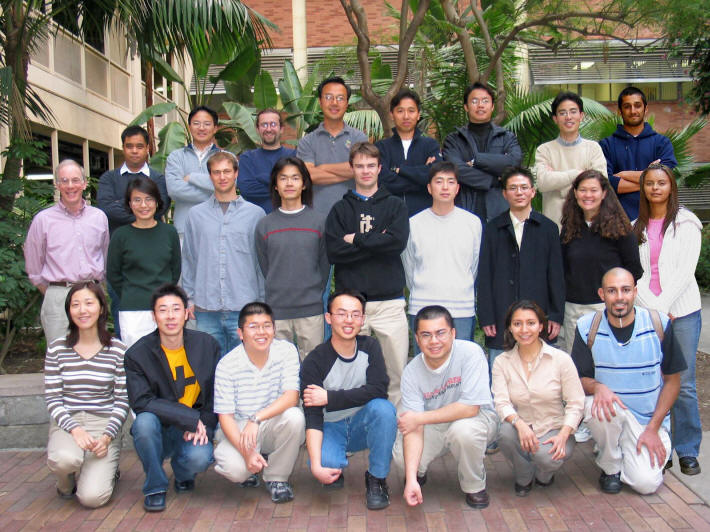
Prof. Bruce Dunn’s Lab
Research in the Dunn group involves the synthesis of inorganic and hybrid materials and characterization of their electrical and optical properties. The various areas are described in greater detail below and representative publications are listed. One of the principal themes which extends to most of the research activities is the use of sol-gel methods to synthesize a number of the materials studied in the group (see http://www.solgel.com/educational/educframe.htm for background on the sol-gel process). This synthetic approach enables us to prepare materials which incorporate a wide variety of organic and biological dopants and are capable of developing unique microstructures and properties.
Electrochemical Materials and
Devices
(Maria Choles, Il-Sup Jin, James Lim, Peter Malati, Derek Min, Kurt Star, Paul Tang, Tim Yeh, John Wang, Miaojun Wang)


One of our research directions involves the use of sol-gel synthesis methods to create electrochemical materials with designed chemistry and microstructure. We are interested in transition metal oxide aerogels and we have been investigating how their high surface area influences electrochemical properties. These aerogel materials exhibit properties which combine the characteristics of both batteries and capacitors, and they are able to reversibly insert a variety of monovalent and divalent ions. We were also awarded a MURI grant to establish the enabling science and technology for creating 3-dimensional nanostructured batteries. Information concerning this program is available at:
http://www.seas.ucla.edu/muri3d
 Another project in the group involves a study of the infra-red optical properties of electrochromic polymers as they cycle between their conducting and insulating states. The electrochromic response of these materials enables them to be considered as infrared active films for the 8 to 12 um range.
Another project in the group involves a study of the infra-red optical properties of electrochromic polymers as they cycle between their conducting and insulating states. The electrochromic response of these materials enables them to be considered as infrared active films for the 8 to 12 um range.

We have recently begun research on biofuel cells, devices which convert the chemical energy of a fuel (glucose) and oxidant (oxygen) directly to electrical energy by utilizing enzymes to catalyze oxidation and reduction reactions. Our research involves the development of an electrode nanoarchitecture in which the enzymes, mediator and carbon nanotubes (conductive component) are immobilized in a sol-gel matrix.
Mesoporous and Bio-Hybrid
Materials
(Jonathan Fang, James Lee, Mark Luo, Annika Pohl, Grant Umeda)

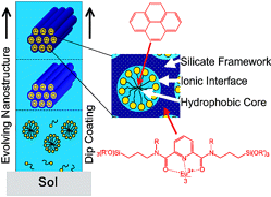 For several years we have been investigating mesostructured materials based on
For several years we have been investigating mesostructured materials based on
the addition of surfactants to sol-gel materials. One direction for this research has been to deliberately control the location of chromophore dopants within the mesostructure and this has enabled us to achieve energy transfer in thin films. In related studies we are synthesizing metallic conducting oxides such as RuO2 as mesoporous films and determining how the mesoporous morphology affects electron transport. Aerogels constitute another important class of mesoporous oxides prepared using sol-gel chemistry. In our current work, we are investigating the thermal transpiration properties of these materials and designing the pore-solid architecture to produce highly effective pumps and micro-propulsion devices.

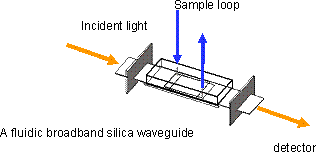
One of our continuing interests is the synthesis of bio-hybrid materials in which the desired biomolecule is encapsulated within sol-gel derived inorganic matrices. The sol-gel chemistry is controlled so that enzymes and antibodies remain stable in the inorganic matrix and retain their characteristic properties and structure. We are using this approach to synthesize unique biosensor materials with excellent sensitivity and specificity. A recent project has involved the development of a sol-gel immunoassay sensor for cortisol, an important biomarker for astronaut health. In another project, we created fiber optic sensors for glutamate, a neurotransmitter. To take advantage of the fast response time of thin films, we are fabricating bio-hybrid materials in a waveguide configuration. The longer path length leads to improved sensitivity.
Biomolecular Materials
(Il-Sup Jin, Steve Jonas, Esther Lan, Mark Luo, Jing Zhou)
We have recently initiated selected research topics which are at the intersection between biology, physical science and engineering. The overarching theme with this research is to try to exploit biological structures for engineering applications.
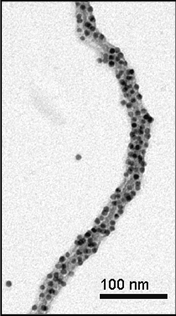
One project involves the metallization of microtubules. Microtubules are fibrous proteins found in nearly all eukaryotes. They are shaped like long hollow tubes about 25 nm in outer diameter and microns in length. The objective in this project is to use the chemical residues on the surface of these self-assembled proteins to bind metal and to fabricate arrays of metallized nanowires . In the work shown here, gold colloids are able to densely cover microtubules that have been stabilized with glutaldehyde.
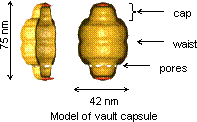
Another project involves the use of vaults, which are nanodimensional protein capsules found in the cells of nearly all animals and plants. We have been working with vaults that have been genetically engineered with enzymes and designed to exhibit chemiluminescence.


In another research project, we have created proteogels in which protein-embedded liposomes are encapsulated in sol-gel matrices. We have used this approach to prepare sol-gel based materials which exhibit photo-induced proton gradients and convert ADP to ATP.
Group Photo:
